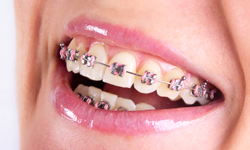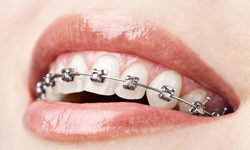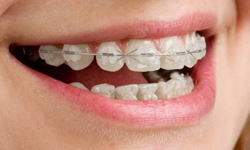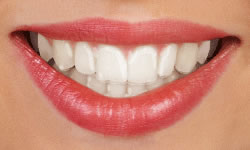When many people think about braces, they imagine the traditional metal brackets on the front of teeth. Although these braces are still very common, there are other options to choose from. Here are the most common types of braces:
Metal Braces

Metal braces use metal brackets and wires to move the teeth into alignment. An orthodontist will cement an individual metal bracket onto the front of each tooth and attach metal wires through each bracket, connecting them altogether. Small bands, which come in an array of different colors, are used to secure the brackets in place.
Metal braces have come a long way in recent years and are smaller than they were in the past. They are less noticeable and don’t cause as much discomfort. Treatment time is typically the shortest with metal braces.
One of the downsides of metal braces, however, is that you may not be able to eat all of your favorite foods, such as popcorn, hard candy, chips, nuts, corn on the cob and crunchy veggies. These foods can easily get stuck between your brackets.
Self-Ligating Braces

Self-ligating braces are similar to metal braces, but they don’t require the use of rubber bands. They use a clip to hold the wire onto the bracket, which leads to less friction on the teeth and fewer visits to the orthodontist. The brackets can be made of metal, ceramic or clear brackets.
Ceramic Braces

Ceramic braces are the same color as your teeth, so they are far less visible than traditional metal braces. They are a great option for adults who do not want others to know that they are wearing braces. Ceramic braces, however, are larger than metal braces and can stain if you do not brush and floss properly.
Invisalign

Invisalign braces consist of clear, removable aligners and can correct mild to moderate orthodontic issues, like overbites, misaligned teeth and open bites. Since these braces can be removed, there is no need to restrict your diet. You can also brush and floss your teeth without any issues. Additionally, Invisalign braces are more comfortable to wear because they do not have wires that poke your cheeks and gums.
While you can remove Invisalign aligners for eating and brushing, you need to keep them in your mouth for at least 20 to 22 hours a day. Otherwise, it may take longer to straighten your teeth.

 Website Powered by Matador Solutions
Website Powered by Matador Solutions